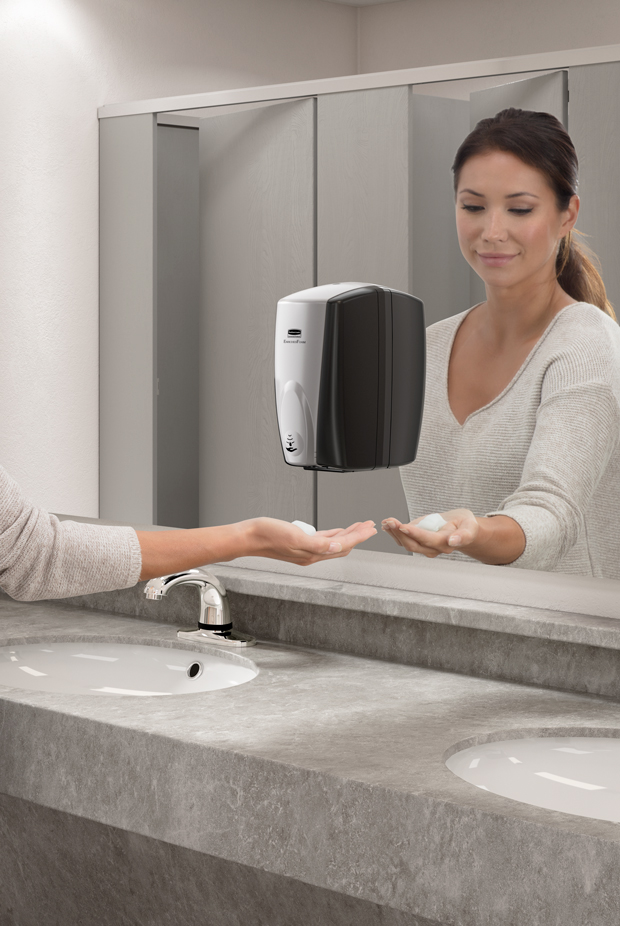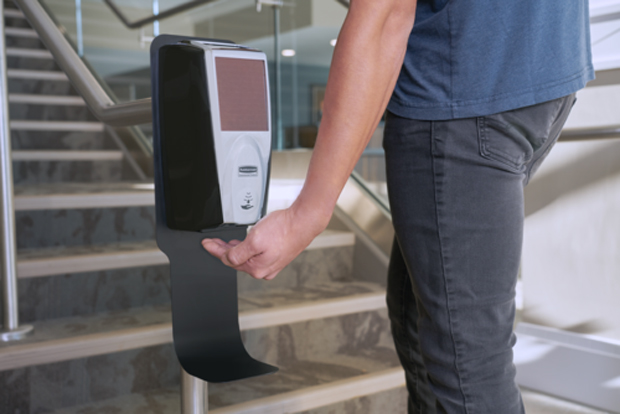Whether it’s in your washroom, front-of-house, reception areas, working spaces or in staff areas, HandSafe hand hygiene genuinely cares for your users’ health and wellbeing, as well as their experience. Being HandSafe means providing high quality hand hygiene, tailored to your facility’s needs. In short, it’s doing more than simply box ticking.
While more businesses are now aware of the importance of good hand hygiene, many are still putting their business at risk through their soap and sanitiser choices.
Here, the experts at Rubbermaid Commercial Products help you identity where poor hand hygiene could be letting your business down and offer their top tips for getting HandSafe.
What are the risks of not being HandSafe?
Damage to your reputation
With 74% of people saying that dirty washrooms cause negative perceptions of a facility1 and 84% saying personal control of cleaning is important in making them feel safe2, your washrooms are just as vital for creating a good impression of your facility as your front-of-house areas. When it comes to providing a high-quality experience, the measures you take to help retain existing customers and attract new ones need to extend to your washroom or you run the risk of damaging your reputation.
Top tips:
- Your customers and employees want to take control with visible and high-quality hand hygiene that’s pleasant to use and works every time. Malfunctioning and grubby-looking soap dispensers or pump top bottles can undermine your efforts elsewhere. Quality and durability are therefore a must.
- With 66% of people saying they use a variety of methods (including flushing the toilet with their feet!) to avoid making contact with anything in a washroom4, offering touch-free hand cleaning with automatic dispensers – preferred by 92% of people5 – will help make sure your washroom doesn’t damage your reputation.
Hitting your bottom line
There may appear to be little difference when it comes to choosing soap and sanitiser dispensers but taking a closer look at the long-term implications of installing the cheapest dispensers you can find reveals the truth. Flimsy dispensers don’t stand the test of time meaning replacements will be required or worse still, backup pump tops installed next to them!
Buying in bulk is often seen as the economical choice, but when it comes to hand hygiene, bulk fill (top up) solutions are deceptive. Larger dose sizes and less concentrated product results in more wastage and more frequent refilling, adding unnecessary cost and hassle you just don’t need.
Top tips:
- Prioritise durability when choosing your dispensers to help minimise replacement costs. Not only that, if you buy better, you waste less and improve your sustainability practices too! Look out for dispensers that come with a lifetime warranty to put your mind at rest.
- Choose dispensers that use hygienically sealed refills for controlled dispensing and more applications per refill. The right amount of product for a safe clean is dispensed without the unwelcome wastage, meaning better cost in use.
Reducing productivity
 If your hand hygiene provision isn’t up to the standards people expect, they’re less likely to use it. With 80% of germs spread by hands6 and viruses able to survive on hands up to five minutes after transfer from a surface7, it’s clear to see that without quality hand hygiene solutions the spread of illnesses such as colds, flu, stomach bugs and COVID-19 becomes more likely. With workers averaging three sick days per year8 productivity losses are high.
If your hand hygiene provision isn’t up to the standards people expect, they’re less likely to use it. With 80% of germs spread by hands6 and viruses able to survive on hands up to five minutes after transfer from a surface7, it’s clear to see that without quality hand hygiene solutions the spread of illnesses such as colds, flu, stomach bugs and COVID-19 becomes more likely. With workers averaging three sick days per year8 productivity losses are high.
If you’re using bulk fill soap and sanitiser dispensers, the risk is even higher – at least 1 in 4 bulk fill hand hygiene dispensers are contaminated with illness-causing bacteria9. There are multiple points on the dispenser where bacteria can contaminate the replenishment supply, such as an open-top lid and push-button. Often, units don’t get cleaned but are “topped off” against guidelines10 and they then cannot be decontaminated; an infected unit must be fully replaced to remove the risk11.
Top tips
- You can help keep your people safe with high quality soap and hand sanitiser in your washroom and throughout your whole facility, encouraging use with visible, touch-free dispensers.
- Go for dispensers that use hygienically sealed refills to keep soap and sanitisers fresh and free from cross-contamination.
Challenging your sustainability goals
User-preferred automatic touch-free dispensers give your users the high quality, HandSafe hand hygiene provision you need, but these dispensers are traditionally powered by batteries, only 5% of which are successfully recycled12. So, touch-free is not enough. For the people-pleasing, environmentally friendly choice, think touch and battery-free hand hygiene dispensers like RCP’s innovative market-leading LumeCel AutoFoam.
Is your soap and sanitiser letting you down?
To speak with one of RCP’s experts about how you can upgrade your hand hygiene and get your facility HandSafe, register your details here.
Sources
1 Cintas
2 Deloitte, “Safety and cleanliness–make it or break it”
3 Zogby International
4 Impulse Research Corporation Survey
5 RCP Facebook Survey 2020
6 University of Arizona Study, Dr. C. Gerba
7 The Journal of Infectious Diseases.
8 BLS.gov
9 Journal of Environmental Health 2011.
10 CDC.gov Guideline for Hand Hygiene in Health-Care Settings
11 Evaluation and remediation of bulk soap dispensers for biofilm, Biofouling 2012
12 Constance Kampfner, The Times
-ends-
To have your industry news published in the pages of FMJ’s news section, Month in FM, and here online on fmj.co.uk, please send your news and image to Danny Grange danny.grange@kpmmedia.co.uk
The view or information contained within these unedited press releases, are that of the company producing it and not necessary the views of kpm.







